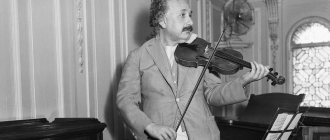Relationship
Each of us is concerned about the problem of mutual understanding with other people. I think that very often in life you have to deal with the fact that with some people you feel comfort, understanding and ease, but with others, on the contrary - irritation, misunderstanding and constant conflict situations. And the point is not that you are somehow “not like that” or “not like that.” Not at all! It is necessary to understand that we are simply all built differently. And socionics helped me understand many relationship issues at one time.
Of course, this is not a magic wand or a red pill that will tell you everything about relationships. For me, this is, first of all, an excellent tool for self-knowledge and understanding the nature of other people. At one time I was close to those people who said that opposites attract, then I thought that it was the other way around – people who are more similar. But in fact, everything turned out to be much deeper and more interesting. It turns out that each of us belongs to a certain psychotype with our own qualities, and there are as many as 16 of them. They are what we are talking about in socionics. But let's talk about everything in order!
Explorer guides
These are free artists who take pleasure in destroying traditions with creative attempts and impulses. The group includes virtuosos, adventurers, entrepreneurs and entertainers. These psychotypes offer unexpected options and generate ideas. They often exhibit strange, laid-back behavior, which is normal for them. It is difficult for them to complete a task during the working day; it is better to give them freedom and allow an individual schedule.
Virtuoso
This is a person who is busy with creativity and has the following characteristics:
- He explores the world with curiosity, is rational and enthusiastic.
- He happily helps others, shares his own experience, and constantly strives to improve life.
- Often mysterious.
- Friendly, but closed, outwardly calm, but restless.
- Makes decisions based on practical experience.
- A brave innovator, he knows a lot and can do it.
Adventurer
Portrait of a psychotype:
- An artist who experiments with appearance and behavior destroys generally accepted traditions and foundations.
- An introvert, he spends periods of solitude on introspection. Often reconsiders his views on life, relationships with loved ones, his place in the world, and his own values.
- He is sensitive to people and feelings.
- He doesn’t look into the future, doesn’t make plans, lives today, at a specific moment.
- Flexible, creative, enthusiastically takes on new projects and tasks. At such a moment, many productive ideas are generated.
Entrepreneur
A successful businessman who is comfortable in the spotlight has the following characteristics:
- He discusses current topics with pleasure, does not plan anything, does everything at once, corrects shortcomings and mistakes right on the go.
- He likes to take risks, has difficulty adapting to society, prefers a free life, working outside of the schedule. It is useless to force such a person into a rigid framework - he quickly loses interest and falls into apathy.
- Under comfortable conditions, an energetic, receptive employee who takes risks if the project fails.
- He has an expressive disposition, but is right in 99% of situations.
Entertainer
Such a person is constantly happy, lives in the moment, his distinctive features are:
- Aesthetically developed, observant, attentive to others, supportive, helpful.
- Avoids conflicts, resolves everything peacefully.
- Prefers luxurious things and often lives beyond his means.
- He doesn't like to plan, so he often loses what he has.
- There is never a dull moment with him – he lifts your spirits and gives you ideas on how to resolve the situation or get out of it.
Sentinel (guardian)
People included in this group divide everyone into strangers and their own. Its representatives - a logistician, a defender, an official and a consul - are rarely ready to compromise with outsiders; they forgive friends everything and protect them from negativity. These psychotypes calmly accept problems, troubles, and feel sorry for the sick, weak, and disadvantaged. If they decide to teach the offender a lesson, they methodically increase pressure on him.
Logistician
Features of the subtype:
- Strictly follows accepted rules and performs duties perfectly.
- He is proud of the work he has done, is guided by facts, and is not obsessed with emotions.
- He is self-sufficient in all situations and will not complain – he considers this a weakness.
- It is difficult to refuse requests, and people take advantage of this.
Defender
Characteristics of a person who consists of contradictions:
- Strives for stability and security, but does not resist change.
- Mostly secretive, silent, but easily fits into the company.
- A true altruist gives himself completely in exchange for gratitude.
- Although he is careful and pedantic in his affairs, fulfills his obligations on time, he often puts off his plans.
Executive
An honest, purposeful manager is a vivid example of the fact that with hard, constant work you can achieve your dreams. The person is a team player and expects real help and effective support. Gets angry when employees don't meet their professional standards. Such an employee is a godsend for the enterprise. An integral personality preserves traditions, fulfills labor standards and norms, and is dedicated to the work.
Consul
For such a person, social status is important, so he is always in the center of the team, listens carefully to people, and delves into the conversation. He loves when he is appreciated, needs his presence, and is sincerely thanked. In such relationships, he becomes an altruist who is obliging, caring, and always ready to help. The situation concerns work, finances or personal problems.
Theory of psychological personality types
Based on their ability to think and act in socionics, all people were divided into groups. Personality types were developed by Isabel Myers and Katherine Briggs.
Their theory, based on the research of Carl Jung, expands on the psychologist's ideas and creates a complete structure of species.
Myers and Briggs proposed four basic characteristics that are used to classify personality type:
- Extraversion and introversion (energy management). Introverts prefer to be alone for a long time, are reserved, and thoughtful. Extroverts enjoy lively, fun environments and are expressive and outspoken.
- Perception and intuition (information processing). Sensory learners focus on the five senses and are interested in what they see, hear, and feel. Intuitive people use abstract thinking, theories, patterns. They are more concerned about the future than the present moment.
- Thinking and feeling (decision making). Thinkers choose with their heads, rely on logic and reason. Sensitive people decide with their hearts and are interested in how it will affect others.
- Judgment and perception (organization of life). Those who are inclined to have their own opinion, advocate order, planning, and do not like change. Perceiving people are flexible, spontaneous, ready to change their mind at any moment, and easily adapt to the situation.
Jung's typology
The basis for dividing people into psychological types is the tendency to predominantly direct vital energy (libido) outward to the situation or partners (extroversion) or to refrain from spending energy and influencing oneself from the outside (introversion). Hence the openness and sociability of pronounced extroverted types and the isolation and tendency to solitude of introverted psychotypes.
Both types of behavior are biologically based. In the animal world there are also two ways of adapting to the environment. The first, “extroverted” - the desire for unlimited reproduction in combination with the weak functioning of defense mechanisms (as in rats, rabbits, lice). The second, “introverted” - a small number of offspring with strong protective mechanisms (in most large mammals). Like animals, what an extrovert achieves through mass contacts with the outside world, an introvert achieves through a maximally independent position.
Carl Jung first introduced the concepts of extraversion and introversion as the main types of ego orientation. And later he supplemented his psychological typology with a description of four basic mental functions:
- thinking (logic);
- feeling (aesthetic judgments and ethical values);
- sensation (perception through the senses);
- intuition (unconscious perception).
Each of the basic psychological functions can be directed both outward and inward - the extraversion-introversion criterion. According to which of the functions is more developed (leading), the individual can be classified as a thinking, feeling, sensing or intuitive extrovert/introvert. The opposite of the predominant function is repressed into the unconscious and gives rise to interesting effects. For example, the thinking type does not like excessive displays of emotions, shouting, or pathos. But the “thinker” will receive the greatest pleasure from communicating with the emotional feeling type.
Small groups
Socionic quadra
Sociotypes that are in identical, dual, mirror and activation relationships with each other form a quadra
. All TIMs of the quadra completely overlap the main personal aspects (also called quadral values) (according to Model A, they occupy the positions of basic, creative, suggestible and activation functions), making communication within the quadra as comfortable and non-conflict as possible.
- 1st quadra - “alpha” - Don Quixote, Dumas, Hugo, Robespierre
- 2 quadra - “beta” - Hamlet, Maxim Gorky, Zhukov, Yesenin
- 3 quadra - “gamma” - Jack London, Dreiser, Napoleon, Balzac
- 4 quadra - “delta” - Stirlitz, Dostoevsky, Huxley, Gaben
Socionics club
Sociotypes that are in identical, mirror, quasi-identical and complete opposite relationships with each other form a socionic club
(another name is setting for the type of activity).
- “scientists”, “researchers” (logicians, intuitives, democrats) - Don Quixote, Robespierre, Balzac, Jack London
- “managers”, “practitioners” (logicians, sensorics, aristocrats) - Maxim, Zhukov, Stirlitz, Gaben
- “socialists” (ethicists, sensorists, democrats) - Dumas, Hugo, Napoleon, Dreiser
- “humanists” (ethicists, intuitives, aristocrats) - Hamlet, Yesenin, Dostoevsky, Huxley
Order ring
Sociotypes that are in a relationship between order and superego form an order ring
.
- extroverted quest ring of order (“energy generators” according to Gulenko) - Don Quixote, Hamlet, Napoleon, Stirlitz
- extroverted declamatory ring of order (“energy carriers” according to Gulenko) - Hugo, Zhukov, Jack, Huxley
- introverted quest ring of order (“information generators” according to Gulenko) - Robespierre, Gabin, Dreiser, Yesenin
- introverted declamatory ring of order (“information accumulators” according to Gulenko) - Dumas, Maxim, Balzac, Dostoevsky.
Other small groups
In total, 35 small groups are known in socionics, formed from sociotypes, in which three (two orthogonal and the third associated with them) of Reinin’s 15 characteristics coincide, in particular:
- “square” (dual, semi-dual and kinship relationships)
- group of socionic temperaments (family, business relationships and superego)
- ring of revision (relations of revision and superego)
- groups of orientation towards the type of activity, or “trade clubs”: scientists, production workers, socialists and humanities (quasi-identity, extinction and mirror relationships) - the relay race between them along the rings of socionic temperaments gives the effect of a hypothetical “change of quadra” of the socion
- other
Analyst
The personality types of this group are distinguished by a sharp mind, logical thinking, the ability to highlight the main thing, fairness and objectivity. It includes strategists, logicians, commanders and debaters. Such subtypes have sharp judgments and principled assessments. If these people are not satisfied with the rules, they are ignored.
Strategist (architect)
Such a person is rare. He has a wonderful imagination, thinking, and indomitable mind. This type is decisive, prone to ambition, does not waste energy, and values his own individuality. A strategist is a cynical idealist who is confident that he will achieve what he wants, does not accept rules or restrictions, and acts according to principles. He is proactive, does not wait to be asked, to explain what to do.
Logician
An educated person who considers himself exceptional, smart and proud of it. This type loves to unravel complex problems and looks for inconsistencies in proven facts. A person is not interested in everyday life, he completely surrenders to situations where he realizes himself. This type is constantly thinking, therefore thoughtful, shy, but changes dramatically during a discussion or argument.
Commanding
This is a charismatic and self-confident leader who easily gathers crowds of attentive listeners and zealous followers, although he talks about ordinary, inconspicuous things. The commander is a dominant person who insists and forces people to accept their point of view.
Wrangler
A thinker who is constantly busy training his sparkling mind. This type is honest, argues tirelessly, and defends an idea even when he doesn’t believe in it. A person studies the subject inside and out so that the opponent has no chances or questions.
Diplomat
Representatives of this group are characterized by an easy-going character, calmness, balance, and a desire for harmony. It includes a mediator, a lawyer, a servant and a protagonist. All subtypes are easy to communicate, receptive, flexible, with restrained emotions. It is difficult to anger such people.
Advocate
Subtype characteristics:
- A rare intuition, it understands what is going on in the head of another, absorbs other people's emotions, and easily looks into people's future.
- Knows where to put pressure on the disputant in order to obtain agreement, sees the problem as a whole, takes into account other people's points of view.
- Suitable for personnel management because he strives to make others happy. At the same time, he forgets about himself and imitates ease.
Mediator
Type Features:
- He is creative, knows how to clearly convey ideas, motivates people to self-development and move forward.
- Instantly calculates prospects, having a minimum of information, predicts the outcome of the situation.
- Easily moves from one topic to another, understands, knows how to convey a thought to a person.
- He is talented from birth, has many hobbies, is energetic, and is devoted to his work without reserve.
- Olivier salad recipes
- Baker's cyst disease of the knee joint
- Sea kale: benefits and medicinal properties
Campaigner
This is an intermediary who is interested in the process, not the final result. The type adheres to moral principles, speaks competently, and is inclined to study languages. The servant concentrates on one task, does not waste effort, does not overestimate his function, otherwise he is left with nothing.
Main character
A frequent guest at parties, the leader of companies, the center of attention is a feature of this type of people. They are not attracted to routine work; self-esteem depends on independently made original decisions. They easily switch attention, know how to relax, rest, and do it with pleasure.
How to determine a person’s psychotype
The Swiss C. G. Jung became the first creator of the classification of psychotypes, which laid the foundation for the science of personality - socionics. The interaction of an individual in society is based on theories of other teachings about human behavior.
In total, the scientist identified eight types. Socionics has identified 16 types, taking as a basis two areas of personality: introverts and extroverts. The first ones have the following names and characteristics:
️Logical-intuitive. Doesn't like empty talk, communicates in essence. Uses logic or intuition to answer questions.
️ Intuitive and logical. He is careful in decisions, weighing the pros and cons, and does not take risks. Loves comfort and tranquility in everything.
️Logical-sensory. Pedant and realist.
️ Sensory-logical. Punctual, honest, sensitive.
️ Ethical-intuitive. A good friend who empathizes and gives advice has the qualities of a nurturer.
️ Intuitive and ethical. He feels people and can win them over. Likes to look good and relax.
️ Ethical-sensory. He doesn’t let strangers into his soul, he stands up for his family.
️ Sensory-ethical
Calmly tolerates routine, does not conflict, appreciates attention and care
The second direction has the same names, but with an extraversion bias.
️Logical-intuitive. Soberly assesses circumstances, which does not interfere with risk. Able to not succumb to provocations, strictly following his goal.
️ Intuitive and logical. He does not like monotony, he is full of new ideas, bringing them to life.
️Logical-sensory. He is caring and sociable with loved ones, but sometimes stubborn. Perhaps this helps to always finish what you start.
️ Sensory-logical. A born winner at any cost. Tends to subjugate.
️ Ethical-intuitive. An emotional and persistent personality, he calculates everything in advance.
️ Intuitive and ethical. Thanks to his powers of observation, he senses people's moods. Will support you in difficult times.
️ Ethical-sensory. He has influence over people, but is also capable of self-sacrifice.
️ Sensory-ethical. Knowing how to manipulate people, he hides his true nature so that it will not be used against him.
The given characteristics are very relevant in our time, they help to identify problems in society.
Psychology and determination of the personality of a criminal
Criminologists have been working on the problem of eradicating crime for a long time. The criminal personality typology is intended to assist law enforcement agencies in this work.
The basis for the psychology of a criminal was laid by the Italian psychiatrist Lombroso. The criminal environment is heterogeneous, and so are the criminals.
All sorts of systematizations are carried out according to various criteria. The motives for committing criminal acts, their degree of severity, etc. are taken into account. There is extensive specialized literature on this topic. Those who want to study this section of psychology in more detail can independently find publications of this kind in libraries, the Internet, etc.
Was last modified: December 17th, 2015 by Elena Pogodaeva
One of the main aspects of human existence is his self-realization in various fields of activity, among which successful adaptation and productive interaction with other people are of key importance. Since time immemorial, philosophers, and then psychologists, have tried to establish certain patterns in human behavior and attitude in order to make relationships between people more understandable and mature.
Thus, even at the dawn of psychology, the Austrian psychiatrist S. Freud formulated a theory about the structure of the psyche, and the Swiss psychiatrist K.G. Jung, relying on this knowledge and his own many years of work experience, created the first concept about psychological personality types. This teaching today has become the basis for many competent socio-psychological theories and even entire areas of modern psychotherapy.
One of these modern theories is socionics as the doctrine of the interaction between a person and the outside world, depending on the personal characteristics of a particular person, which classify him as one of 16 socionic personality types.
Socionics as a science was created in the seventies of the last century by the Lithuanian scientist Ausra Augustinaviciute on the basis of computer science, sociology and psychology. In the scientific community, socionics is rather not a science, but one of the famous personality typologies, which serves as a diagnostic method in psychological counseling.
EGO
Socially demonstrative, creative block; a means of consciously influencing the world; accurate self-assessment block; block of in-depth study of one of the parameters of the external world; a block that requires recognition adequate to its abilities. “The EGO block does not know doubts, worries, or remorse. This bloc does not blame others either, it does not shift responsibility onto them” [2, p.83].
The creative function needs to be understood, otherwise working on its aspect does not bring joy. Creative is a means of achieving the goal outlined by the second, productive element of the SUPEREGO block (4th Function) and finally formulated “under the supervision” of the program. “The EGO solves problems born on the SUPEREGO” [2, p.57].
EGO - personal contribution to changing the external situation; each person subordinates those around him to his program function: - his sense of time, rhythm; — your vision of opportunities and prospects; - of your own free will, etc. The activity of the EGO (kinetic mental block) is limited by health, intelligence, education, range of interests, and the need of society for the potential abilities of the individual.
Optimists, pessimists and realists
- Lyokha, well, how much longer do I have to read?
Now let's move on to classifying people into optimists, pessimists and realists.
Optimists
There are 3 types of optimists.
Complete optimist
In a good sense of the word, the main principle of his life is to think positively, no matter what.
Pessimists
Pessimists are divided into 2 types.
Pessimist from birth
Looks askance at everyone who thinks positively. From birth he has a grumpy character. He makes dark jokes and assumes the worst.
In another way, he can be called a skeptic.
Realists
The realist is the only sober person in the whole trio. He analyzes the situation and only after that decides whether it is good or bad. There are 2 types of realists.
The realist is false
A pessimist who hates other pessimists and hides under the guise of a realist. It is easy to distinguish him from a true realist - a false realist is vulnerable and does not know how to control himself.
Why is socionics needed?
The concept of socionics helps to better understand yourself and others, productively solve personal and professional problems, discover true talents and realize yourself in the right direction. Basic knowledge of personality prototypes also allows you to find common ground in controversial issues between family, friends, and strangers, and to accept your opponent’s worldview.
Interesting. If you correctly determine the sociotypes of people, it will not be difficult to predict their behavior in certain situations. Understanding the characteristics of sociotypes simplifies the selection of work teams. For individual tasks, it is worth selecting a candidate who can cope in the best possible way.
What is a psychotype
Any person represents a unity of the general and the individual. Recognizing the right of everyone to be a bright and unique personality, we must understand that the laws by which the psyche works are common to everyone, which means there are many similarities between people. This allows psychologists to draw general conclusions and develop effective and applicable methods of psychotherapy and correction to all individuals.
But along with general and individual traits, there are also typical ones, that is, they allow people to be united into groups (types) based on some common characteristics. In this case, we will talk about psychological characteristics and, accordingly, psychotypes. A psychotype is a complex of mental characteristics that make up a generalized model of human behavior and his reactions to external stimuli. These patterns are characteristic of many people, which allows them to be grouped together.
Why are such classifications needed? Psychologists need them to use different approaches to working with clients according to their types. However, too general methods and advice are not always effective, and it takes a lot of time to understand the individual “cockroaches” of each person. It’s easier to start from typological features and start analyzing individual problems and choosing work methods from them.
Here's an example. According to the characteristics of contacts with the outside world, all people can be divided into two types: extroverts and introverts:
- Extroverts are open to the world and other people and draw their energy from outside themselves.
- Introverts are closed in their inner world; they have difficulty building relationships with others and focus on their own resources.
It is clear that in order to develop the correct strategy for communication and interaction with a client, a psychologist needs to know what type he is.
It is also useful for ordinary people to know about their own psychotype. Such information allows you to interact with the world more effectively and avoid many mistakes. That is, knowledge of psychotypes is a useful thing, and special tests have been developed to determine them.
True, there is one problem: there are so many different typologies, classifications and their descriptions that it is not easy for even a psychologist to understand them. Therefore, I will introduce you only to the most popular ones.
SUPEREGO
Socially conforming block; a means of displaying the outside world; a block of “standards” that a person tries to comply with; block of orientation in objective reality; "conscience" of a person. SUPEREGO never argues, but only argues, without adding almost anything new, takes into account everything known in its aspects. “SUPEREGO is an omnivorous block, greedily absorbs all information related to its elements” [2, p. 138]. The first tact of the SUPEREGO (3rd function) is not able to independently respond to changes (for example, LII and LSI cannot switch to a new “feeling mode”: they must be “transferred” by someone from the outside). The absence of impacts on the 4th function is proof that the individual meets the expectations of others. Everyone’s dream is for their understanding of the 4th function aspect to coincide with “public opinion.”
A person needs empathy for aspects of his SUPEREGO block. But this is only possible if the functions of the block are rich in information, that is, they have social value. “It is precisely according to the aspects of the SUPEREGO block that they try to raise their value for society, and when this fails sufficiently, their conscience gnaws” [2, p. 14].
“The EGO block becomes energetically active only after it acquires followers who want to use its ideas, but are not able to implement them on their own. The SUPEREGO also moves from talk to action only after people provided with its information begin to act themselves and it is simply necessary to align their line of behavior” [2, p. 166].
Sanguines, cholerics, phlegmatics and melancholics
Hippocrates was the first to divide people into temperaments. Claudius Galen supported his idea and created the scientific treatise “Correct Measure”.
There are 4 types of human temperament:
- Sanguines.
- Cholerics.
- Melancholic people.
- Phlegmatic people.
Sanguines
Sanguine people are optimists. They look at the world through rose-colored glasses. They cannot sit still and are constantly on the move.
Sanguine people love to be the center of attention, so they can be classified as extroverts. They are easily excited and drawn into new things.
They get along well with people, know how to find compromises, speak in public and lead.
They love to travel, discover new things and explore the world around them.
A sanguine person will maximize his abilities if he becomes an actor, motivational speaker, teacher, journalist or lawyer.
Psychological characteristics
Sanguine people have an easily excited nervous system, developed thinking and memory
The first thing they will notice is your bright clothes or strange hairstyle.
They do not hide their emotions, empathize with others, and actively gesticulate. They may hug or kiss you when they meet, even if they have never seen you before.
They don't like monotonous work. They like to change hobbies or professions. Experiment with image.
They have many friends
In personal relationships, they pay special attention to communication
Disadvantages of Sanguine People
- They can get down to business and not finish it.
- They overestimate their capabilities.
- Their mood often changes. It is difficult for them to develop willpower.
Cholerics
They have a strong character and discipline. They take on difficult things. They know how to persuade and speak.
They don't keep bad memories. They easily forgive enemies. They organize people well and distribute tasks.
Choleric people say what they think and can be rude. They change their mood quickly. Gestures are actively used.
Cholerics are jealous. There are often scandals in the family. In childhood, they are capricious and hyperactive.
Disadvantages of choleric people
- They are in a hurry and do not think about the consequences of their own actions.
- They don't know how to wait.
- They have an unbalanced character.
- Harsh communication.
Phlegmatic people
For me, this is the best temperament. Phlegmatic people are balanced. They think through their actions carefully. They have an analytical mind.
They do not like vigorous activities. They prefer activities that don't require much effort.
Phlegmatic people are closed and secretive. They are reluctant to communicate. If they find friends, they stay friends with them all their lives.
Disadvantages of phlegmatic people
- They rarely take initiative.
- Uncommunicative.
- They adapt poorly to new circumstances.
- They keep their emotions to themselves.
Melancholic people
Melancholic people have an unbalanced psyche. They often fall into despair. They tend to worry about little things. Their character is sluggish and pessimistic.
A melancholic person sees life in negativity. He tries to find flaws in everything. He is often attacked by feelings of melancholy and self-pity.
A melancholic person suffers from an inferiority complex and low self-esteem. He behaves sluggishly and apathetically.
The melancholic person is unsociable. It is difficult for him to find friends and a soul mate due to indecisiveness and timidity.
However, this personality type also has positive sides. Melancholic people are kind and will share with you the last thing they have.
Disadvantages of melancholic people
- Unstable emotional state.
- Difficulties in communication.
- Weak character.
- Tendency to depression.
My friend, about whom I spoke above, is probably melancholic.
Psychologists advise people with this temperament to travel more, play sports and communicate more. Get over yourself and leave your comfort zone.
What Socionics Recommends for Types
Important! Sociotype is a constant of personality, its stable inner core without taking into account the changeable shell. The destruction of this core leads to neuroticism of the personality
Raising children taking into account temperament - recommendations from socionics
Socionics and children. What's the best way to raise children knowing temperament? Socionics recommendations for raising children with linear temperament...
Read
How to develop weak functions? – socionics recommendations
Recommendations of Humanitarian Socionics. How to develop weak functions? Ethics of emotions, business logic, power sensory, intuition in socionics...
Read
Socionics. Personality type Entrepreneur (ENTJ, Jack London, Logical-intuitive extrovert) - problems, advice, recommendations of socionics. New, necessary thing...
Read
Personality type Analyst (INTJ, Robespierre, LII) – problems, advice, recommendations of socionics
Socionics. Personality type Analyst (INTJ, Robespierre, Logical-intuitive introvert) - problems, advice, recommendations of socionics. Analytical mind, structural...
Read
Enthusiast personality type (ESFJ, Hugo, ESE) – problems, advice, recommendations of socionics
Socionics. Enthusiast personality type (ESFJ, Hugo, Ethical-sensory extrovert). In everyday life you are an open, sociable person...
Read
Intertype relationships
Intertype relationships are relationships between representatives of sociotypes, determined by the location of socionic functions in Model A. There will be different types of relationships between people with different sociotypes, since each type perceives and processes information in its own way. There are several types of relationships between different types; they depend little on the aspirations and desires of people.
According to the theory of intertype relationships, there are 14 types of intertype relationships between representatives of 16 sociotypes: identical, dual, mirror, activation, related, semi-dual, business, mirage, repayment, superego, quasi-identical, conflict, order, revision.
All types of intertype relations, except for social order and revision, are symmetrical. The relationship between social order and revision is asymmetrical.
See More About TIM Interaction.
Table of intertype relationships
| Table of intertype relationships | |||||||||||||||||
| ILE | SEI | ESE | LII | EIE | PWD | SLE | IEI | SEE | OR | LIE | ESI | FEL | EII | IEE | SLI | ||
| ILE, "Don Quixote" | Id. | Dual. | Act. | Mirror | Zach. | Rev. | Del. | World. | SE | PP | CT | Conf. | PZ | ETC | Genus. | PD | |
| SEI, "Dumas" | Dual. | Id. | Mirror | Act. | Rev. | Zach. | World. | Del. | PP | SE | Conf. | CT | ETC | PZ | PD | Genus. | |
| ESE, "Hugo" | Act. | Mirror | Id. | Dual. | Genus. | PD. | PZ | ETC | CT | Conf. | SE | PP | Del. | World. | Zach. | Rev. | |
| LII, "Robespierre" | Mirror | Act. | Dual. | Id. | PD | Genus. | ETC | PZ | Con. | CT | PP | SE | World. | Del. | Rev. | Zach. | |
| EIE, "Hamlet" | PZ | ETC | Genus. | PD. | Id. | Dual. | Act. | Mirror | Zach. | Rev. | Del. | World. | SE | PP | CT | Conf. | |
| LSI, "Maxim Gorky" | ETC | PZ | PD | Genus. | Dual. | Id. | Mirror | Act. | Rev. | Zach. | World. | Del. | PP | SE | Conf. | CT | |
| SLE, "Zhukov" | Del. | World. | Zach. | Rev. | Act. | Mirror | Id. | Dual. | Genus. | PD | PZ | ETC | CT | Conf. | SE | PP | |
| IEI, "Yesenin" | World. | Del. | Rev. | Zach. | Mirror | Act. | Dual. | Id. | PD | Genus. | ETC | PZ | Conf. | CT | PP | SE | |
| SEE, "Napoleon" | SE | PP | CT | Conf. | PZ. | ETC. | Genus. | PD | Id. | Dual. | Act. | Mirror | Zach. | Rev. | Del. | World. | |
| OR, "Balzac" | PP | SE | Conf. | CT | ETC | PZ | PD | Genus. | Dual. | Id. | Mirror | Act. | Rev. | Zach. | World. | Del. | |
| LIE, "Jack London" | CT | Conf. | SE | PP | Del. | World. | Zach. | Rev. | Act. | Mirror | Id. | Dual. | Genus. | PD | PZ | ETC | |
| ESI, "Dreiser" | Conf. | CT | PP | SE | World. | Del. | Rev. | Zach. | Mirror | Act. | Dual. | Id. | PD | Genus. | ETC | PZ | |
| LSE, "Stirlitz" | Zach. | Rev. | Del. | World. | SE | PP | CT | Conf. | PZ | ETC | Genus. | PD | Id. | Dual. | Act. | Mirror | |
| EII, "Dostoevsky" | Rev. | Zach. | World. | Del. | PP | SE | Conf. | CT | ETC | PZ | PD | Genus. | Dual. | Id. | Mirror | Act. | |
| IEE, "Huxley" | Genus. | PD | PZ | ETC | CT | Conf. | SE | PP | Del. | World. | Zach. | Rev. | Act. | Mirror | Id. | Dual. | |
| SLI, "Gabin" | PD | Genus. | ETC | PZ | Conf. | CT | PP | SE | World. | Del. | Rev. | Zach. | Mirror | Act. | Dual. | Id. | |
| Abbreviations: Id. — identical relationships, Dual. - dual relationships, Act. — activation relations, Zerk. - mirror relationships, Rod. - family relationships, PD. - semi-dual relationship, Del. — business relations, Mir. - mirage relationships, SE - superego relationships, CT - quasi-identity relationships, PP - complete opposite relationships, Conf. — conflictual relationships, Zach. - order relationships (You are a customer), PP - order relationships (You are a customer), Rev. - audit relations (You are an auditor), PR - audit relations (You are a sub-auditor). | |||||||||||||||||
| Explanation: to determine intertype relationships in the table, we find our type in the left vertical column, the partner’s type in the top line, and the intersection of the row with our own type and the column with the partner’s type will show intertype relationships. | |||||||||||||||||
Psychogeometry
American psychologist Dillinger proposed dividing psychotypes based on psychogeometry. In her opinion, each person can be associated with a certain geometric figure. As with other classifications, mixed types are most common, however, one will still be predominant.
Now you know how to find out your personality type. Choose the classification that interests you most. You can also determine your psychotype in each option. Remember that there are no pure types, just one that is dominant.
SUPERIDE
Block for displaying an objective picture of the state of the body; well-being; block of helplessness, dependence on external objects. In psychologically difficult situations, it is the last resort through which a person explains his behavior and looks for a way out of the impasse: - by work (5th function -), - by improving his well-being ().
When implementing aspects of SUPERID, an individual is afraid to oppose his interests to the interests of others. Therefore, there is a need for external adjustment for the 5th and 6th functions. On SUPERID, a feeling of “guilt of others” develops for a person’s failure in terms of suggestive and activation functions. The accepting 5th patiently endures very sharp criticism and even perceives it as concern. The productive 6th - “mimosa-like” - reacts painfully to criticism and comments because it only expects support.
SUPERID, with its weakness and helplessness, provokes the dual’s EGO functions into active activity. No one can cope with their own SUPERID on their own; The more a person is looked after in terms of aspects of this block, the higher his vitality and energy. In general, during cooperation in a dual couple, the initiative constantly changes hands; it is even difficult to figure out who is a follower in which case and who is a mentor. The success of cooperation between duals is that their models are formed from identical (in terms of aspects) blocks, but each block in one is potential, and in the other, kinetic.
Why are types of people identified in psychology?
The problem of personality typology was raised by Carl Jung back in 1921 in his work “Psychological Types.” The Swiss psychiatrist explained the fundamental theoretical disagreements of many prominent scientists by differentiating people by psychological type. For example, Jung explained Sigmund Freud’s desire to look for the reasons for human behavior in the unconscious by the psychoanalyst’s introversion. Alfred Adler's attempts to consider the development of the psyche in the social context of his extraversion.
Despite the fact that it is easier for a person to perform activities characteristic of his psychotype, the scientific division into psychological personality types does not imply negative labels, does not impose restrictions on freedom of choice, and does not prohibit development in any desired direction.
Types of people in psychology are only a description of the characteristics of mental organization. Knowing your own type of psychology helps you see your strengths and stop biting yourself for what doesn’t work out despite your efforts. The ability to determine the psychological types of people allows you to choose a suitable life partner, improve relationships at work and in the family, and successfully resolve conflicts. Knowledge of psychological typologies makes it clear that behind the opposite position there is often hidden not the stubbornness of character or the stupidity of the opponent, but a different perception of the world, a different coordinate system.
Areas of use
Types of human temperament and their brief characteristics
Knowledge of the basics of socionics gives good returns in the following cases:
- Staffing classes and study groups. A harmonious combination of the temperamental characteristics of the types contributes to a friendly working atmosphere and automatic resolution of discipline problems.
- Subject-differentiated training in high school and university seminars, where the priority will be the “club”, discussion method of considering issues.
- Individual approach to students to provide opportunities for self-realization.
Knowledge of the types of people in socionics simplifies management consultations for organizations and contributes to the creation of a stable team of broad-spectrum employees and target groups for the implementation of specific tasks. Sociologically competent staff formation saves people’s money, time and nerves.
The best sociotypes in business
Pseudoscience makes an invaluable contribution to self-development and harmonization of relationships in the family and society. Perception of oneself, possible scenarios for the development of relationships helps to identify hidden mechanisms of quarrels, misunderstandings, and prevents the likelihood of irreparable mistakes.
Formation of names
How did socionics get its name from specific personality types?
The name of the type comes from the dominant attitude (extroversion or introversion), and the two most powerful functions of the four, while the names of the functions have undergone some changes: thinking and feeling became logic and ethics, respectively, and sensation was called sensory. Rationality and irrationality are determined by the location of functions in the names of psychotypes. If we talk about rational personality types, then the first word in the name will be logic or ethics, and for irrational personality types – sensory or intuition.
The names of the 16 types were added over time by various scientists to provide a clearer accessible description of a person. The most popular names of these types are: formulaic names based on Jung’s theory, pseudonyms of famous historical figures - bearers of the designated characteristics, pseudonyms that characterize a person’s professional predisposition.
Signs of Reinin
In 1980, Ausra Augustinaviciute and Larisa Kobrinskaya suggested that in addition to four Jungian dichotomies, there are 11 more dichotomous features formed by multiplying Jungian dichotomies. Later, mathematician Grigory Reinin provided a mathematical basis for this hypothesis, and therefore the signs received his name. Reinin's signs are currently used in socionic diagnostics (typing) by some socionic schools, while other schools do not recognize them (see below).
Features formed by multiplying two Jungian dichotomies
- Democracy/aristocracy = Logic/ethics * Intuition/sensory
- Compliance/stubbornness = Logic/ethics * Extraversion/introversion
- Forethought/carelessness = Intuition/sensing * Extraversion/introversion
- Constructivism/emotivism = Logic/ethics * Irrationality/rationality
- Tactics/strategy = Intuition/sensory * Irrational/rational
- Statics/dynamics = Extraversion/introversion * Irrationality/rationality
Explanation. Dichotomies are multiplied as follows: Democracy/aristocracy = Logic/ethics * Intuition/sensory means that democrats are intuitive logicians (Don Quixote, Robespierre, Jack London, Balzac) and sensory ethicists (Dumas, Hugo, Napoleon, Dreiser), and aristocrats - sensory logicians (Maxim Gorky, Zhukov, Stirlitz, Gaben) and intuitive ethicists (Hamlet, Yesenin, Dostoevsky, Huxley). Other dichotomies are multiplied similarly.
Features formed by multiplying three Jungian dichotomies
- Positivism/negativism = Logic/ethics * Intuition/sensory * Extraversion/introversion
- Process/result = Logic/ethics * Intuition/sensory * Irrationality/rationality
- Fun/seriousness = Logic/ethics * Extraversion/introversion * Irrationality/rationality
- Reasoning/decisiveness = Intuition/sensing * Extraversion/introversion * Irrationality/rationality
A feature formed by multiplying four Jungian dichotomies
- Questionability/declamation = Logic/ethics * Intuition/sensory * Extraversion/introversion * Irrationality/rationality
Characteristics that differ in a dual pair are called individual; characteristics that are common to a dual pair, but differ between two dual quadra-dyadic pairs; signs common to the entire quadra are quadral.
Criticism of Reinin's signs
Not all socionics recognize Reinin’s signs. Critics of Reinin's signs (V. Ermak, M. and D. Lytov) note that in this hypothesis there has been a revision of a number of basic socionic concepts, and also criticize empirical studies of Reinin's signs for methodological incorrectness. Nevertheless, in socionics there are still more supporters than opponents of Reinin’s signs.











